Did your Laminate flooring got water Damaged? Wondering If it can be dried out and repaired?
In this guide you will learn:
- Common Signs of Water Damaged Laminate Flooring,
- What to do if your Laminate floor got Wet & How to Dry it out,
- How to Repair your Water Damaged Laminate Flooring,
- How to Prevent Laminate Water Damage in Future
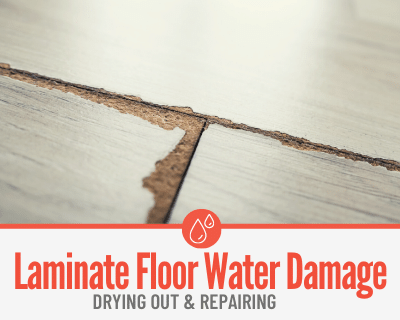
Can Laminate Flooring Get Wet
Although some Laminate flooring is rated to be water-resistant for a certain amount of time, most laminate flooring should not be allowed to get in contact with water!
How long does it take for water to damage laminate flooring will depend on the brand/type of laminate flooring you have installed.
The most premium and water-resistant laminate floorings will retain their original shape and dimensions when exposed to water on top of them for approximately two hours.
Anything more than 2-3hours is considered “the point of no return,” as the flooring begins to soak up water at that point for this type of flooring
For Regular Cheap/Mid-range Laminate Flooring, you only have a few minutes to act before it will start absorbing the moisture.
For this type of laminate as soon as it has started to soak up the water it will start to swell up causing permanent water damage.
Other factors such as higher temperatures or increased humidity can factor in as well.
It’s important that you get water up off of the floor as soon as possible, and take preventative measures so as not to push your luck.
If you’re installing laminate flooring in a bathroom, any manufacturer precautions should be followed exactly to the letter.
Guest bathrooms or even half bathrooms aren’t an as great of a concern due to there being less chance of standing water in them, but in those cases, you should keep an eye out around the toilets and sink.
Make sure your laminate is installed per the manufacturer specifications, and minimize any splashes while staying vigilant for leaks.
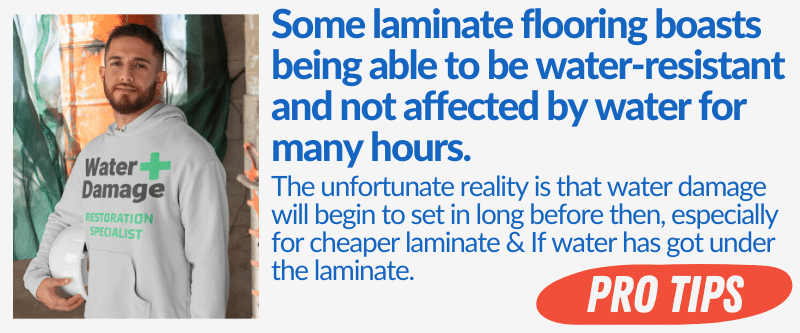
Signs of Water Damaged Laminate Flooring
No one can be on the lookout twenty-four hours a day, and there may come a time when your laminate flooring comes in contact with water for an extended period of time.
Here we’ll go over some ways to help identify when water damage to your laminate flooring has occurred, how serious each one is, and what your best course of action will be.
Swelling
Swelling is the most common sign of water damaged Laminate. As MDF Structure of laminate absorbs moisture it will start to deform and swell up.
This will be the most apparant at the gaps of the laminate where it joins together, this is where the water can find it’s way in.
Once the moisture has been absorbed by laminate and it has become swollen ,even if it’s competely dried, the swollen appearance will remain due to now deformed MDF structure.
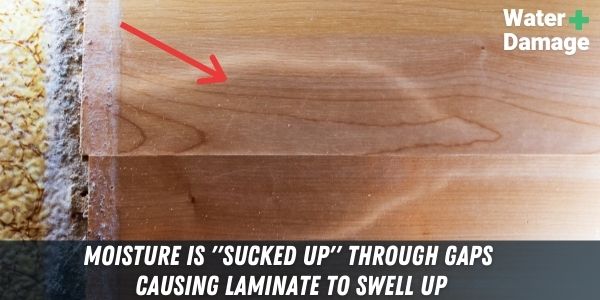
Warping
Another common result of water damage to your laminate, warping is when the edges of your laminated floor begin to rise up and create an uneven surface in your flooring.
If you notice that your laminate flooring is beginning to bubble along the surface, this is typically accompanied by warping and is a sign that it has absorbed moisture.
Unfortunately, warped laminate flooring cannot simply be repaired, and will need to be replaced.
Once the water damaged laminate planks have begun to warp, the edges will no longer line up or lock together properly, preventing them from being reused.
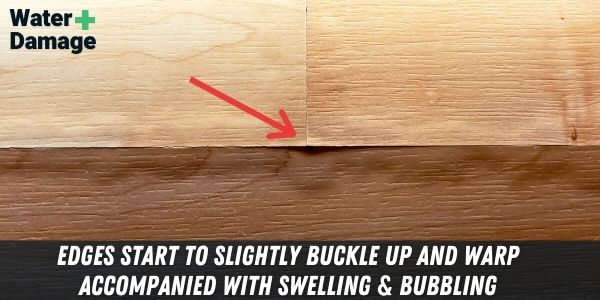
Splitting or Separating
In some instances, when the laminate flooring dries out, it may separate, leaving splits/gaps between the planks.
When this happens, the good news is often this is an easy fix, but before you attempt to make any repairs you’ll want to ensure that the flooring is completely dry, and that it hasn’t sustained any other kind of damage in the process.
Once you’re sure there isn’t any other damage, you can acquire what is known as a gap repair kit. These consist of an aluminium block with a sticky or adhesive substance on the bottom, as well as a rubber mallet.
Taking the aluminium block in hand, you’ll place it adhesive-side down on the plank where the gap is located, and use the rubber mallet to tap the board back into position, closing the gap.
Do this as long as necessary, following the planks all the way back to the wall if need be. If done correctly, this is a cost-effective and time-saving alternative to having to uninstall moulding and flooring, and replacing laminate planks.
Again, just be certain there aren’t any other signs of water damage that may indicate planks need to be replaced.
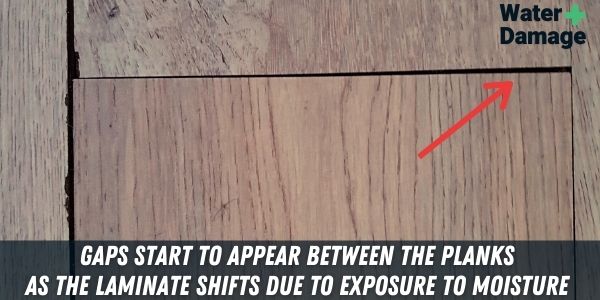
Discoloration
Sometimes, water damage can be as simple as discolored spotting on the surface of the floor.
When this happens, however, there isn’t any real way to fix it.
Solutions like sanding and re-staining the area simply aren’t an option like they are with hardwood flooring, so the only course of action is to replace the water damaged laminate planks.
While replacing instead of repairing isn’t the best-case scenario, there is one silver lining to discoloration: its easy to spot.
Discoloration is cosmetic damage, so as long as the structural integrity of the floor isn’t compromised, there’s no serious rush to get it replaced if it isn’t in your budget at the moment.
Just make sure the floor is dried out properly to prevent any further damage from occurring.
Buckling
Buckling is not always water-damage related however it occurs when there isn’t enough room for the flooring to expand and contract due to a change in humidity in the air.
More often than not, buckling happens around walls where the laminate has run out of room to freely expand. Buckling is easily identified by an arch or bump rising up in the laminate flooring itself.
When left unaddressed, buckling can lead to greater wear and tear on that section of your laminate flooring, which could lead to greater problems and more expensive repairs, so you’ll want to address the issue as soon as possible.
If buckling occurs, there’s a good chance a simple reinstallation will fix it, but you shouldn’t have to replace more than a plank or two. The installation process is fairly simple, and we’ll go over it in detail later on in this guide.
Mold or mildew
Most commonly occurring in particularly damp or humid areas with low lighting or dark conditions, mold growth is a serious health risk and one of the most obvious signs of water damage.
Mold growth can manifest in different ways, whether it be a literal fuzzy growth on the surface and along the seams of your laminate planks,in dark speckled patches scattered across an area or the mold can even grow under your laminate.
Mold is the most dangerous of the signs of water damage, and at first signs should be dealt with immediately to prevent major health problems.
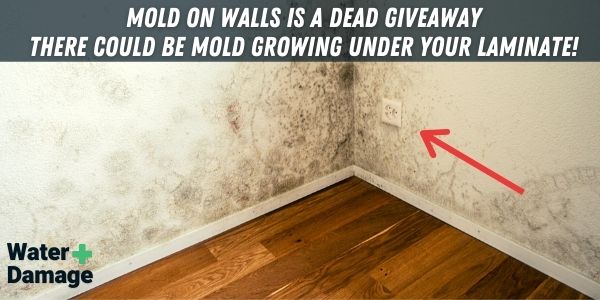
If the mold damage on your laminate isn’t too severe, you can attempt to remedy the situation yourself.
When handling mold, you should take all safety precautions to protect yourself so as not to worsen any underlying health issues you may have such as asthma or COPD.
- You’ll start by mixing equal parts water, rubbing alcohol, and white vinegar in a bucket.
- Vinegar and rubbing alcohol for their antimicrobial properties, and also the alcohol due to the fact that it will help the liquids evaporate quicker, thus preventing further moisture damage.
- Using a mop, dampen it in the cleaning solution you’ve just created and use it on the surface of the laminate floor where the mold is present.
- It may take several runs with the mop to get the stains up completely.
- For more stubborn mold stains, dampening a soft cloth in pure rubbing alcohol may be necessary.
If you’ve tried the remedy outlined above and the mold persists, you’ll want to contact a mold specialist right away, and there is a good chance that section of the flooring will need to be replaced.
Continue Reading: Mold Under Laminate Flooring
As stated before, mold is the most dangerous of the signs of water damage, and should not be left untreated.
Water Damaged Laminate Flooring?
Call 844-488-0570 for a Risk Free estimate from a Licensed Water Damaged Floor Restoration Specialist in your area.
We Can Help Dry out & Repair Your Laminate Flooring
Laminate Flooring Got Wet – How Bad Is It?
When assessing how bad the water damage to your laminate flooring may or may not be, it’s important to take in to account the severity of any existing symptoms.
If your entire laminate floor is speckled with black mold, for instance, you’ll want to call in an expert right away to ensure it hasn’t gotten anywhere else.
If your laminate floor planks have become visibly damaged, such as warping, bubbling, or separation of the layers, unfortunately it simply isn’t possible to repair the old water damaged laminate boards and reuse them. They will need to be replaced.
Special Water resistant Laminate flooring meant for wet areas is designed to be resistant to water, but once water gets in and the damage is done, there’s just no fixing it.
Laminate planks are built to interlock with a system of grooves and tongues.
If water seeps in and causes those components to warp, twist, or contort in some other way, they won’t fit together snug like they’re supposed to.
When this happens, your laminate flooring cannot be properly installed, resulting in an uneven surface among other issues.
Otherwise, if you find that the damage to the flooring is very mild, and that they’re still able to interlock as they’re supposed to after they’ve completely dried, repairs and reuse are a possibility.
Just use common sense, and if you’re uncertain about one, it’s probably better to replace it just to be on the safe side.
Better to error on the side of caution than risk compromising the safety and integrity of your flooring.
How To Soak Up And Remove Water From Laminate
When laminate flooring gets wet, its crucial to get the water up as quickly as you can.
If the water has remained in contact with the laminate for more than an hour, it has already begun to seep in, and depending on how much water there is you may want to take extra steps to help get your flooring dried out as thoroughly as possible.
The obvious first step is to mop up any standing water on the floor. The application of a mop or even some towels will work in this regard.
From there, you’ll need to assess whether any water has gotten between the laminate and the subflooring.
Usually, this can be determined by walking around on it a bit. If the floor feels spongy, soft, or squishy when you step on it, you have water between the laminate and your subflooring.
Next, you’ll want to get a hold of some equipment, specifically some fans and dehumidifiers.
If you’ve read our other articles on drying out floors, you already know how crucial these pieces of equipment are.
- Depending on how wet the flooring got, you may want to use more than one of each.
- Position them in such a way that the fans are angled downward, and blowing directly onto the floor.
- Set up dehumidifiers, and position them strategically around the affected area.
- Keep everything running at full blast, and empty your dehumidifiers as often as necessary to ensure they stay running.
- A wet vacuum is another great tool for getting water out of the floor. You can acquire one or often even rent one from a local hardware store, and it will allow you to suck moisture up out from between the seams of the planks.
- Take your time, move slowly over each affected seam, and allow the vacuum to remove as much water as possible as you go.
In some instances, if the water between the laminate and the subflooring is substantial, you may want to consider removing some planks. To do this, you’ll remove the molding along the wall nearest the affected area, and start separating them out one by one.
Even if you only remove a few, it should give you enough space to spread the planks out so that the air from the fans can get between them and underneath them.
If your laminate planks are glued together, removing a few might not be as easy, but you will still want to consider it especially if the water beneath the laminate is substantial.
Just remove them as outlined above, while taking extra care not to snap or otherwise break the tongues and grooves they’re connected by.
Whether they’re glued in place or not, you will need to give the flooring plenty of time to dry. Patience is a must in this instance, as the process could take days, or even weeks for the flooring to fully dry out.

To help prevent laminate planks from twisting, avoid using any heat while drying your flooring out. Opening a window to allow air in can help the drying process along, but if it’s particularly hot and/or humid outside, it could wind up being a detriment instead.
A cool ambient temperature with constant air movement and running dehumidifiers is the ideal environment for your laminate flooring to dry out and retain its original shape.
Do I have to replace the Subfloor under a Water Damaged Laminate Floor?
The short answer? Perhaps. It depends on several factors, such as:
• The type of subflooring
• How long it was in contact with water
• Whether or not it has begun to rot
• If there is severe mold growth
• Whether or not the subflooring has been structurally compromised
If your subflooring is a concrete slab, and has begun to crack, you’ll want to have it repaired or replaced, depending on how bad it is.
If the subflooring is made of wood, particularly on a second floor above another room, you’ll want to carefully inspect to make certain that it’s still safe.
If a musty, damp odor occurs, or the floor begins to visibly sag or droop, these could be signs of mold or mildew and rot.
In both instances, your best bet would be to at the very least have a professional come out and inspect the subflooring to ensure it’s still safe. The last thing you want is for your subflooring to give out.
Any time you’re worried about whether or not your flooring is safe, you shouldn’t hesitate to get in contact with a professional to come take a look.
If it’s had ample time to dry out and its still springy and bounces with each step, there’s a chance rot has begun to set in, and that isn’t a risk you should take.
How To Fix Laminate Floor Water Damage
Once your laminate flooring is dried, you’ve assessed what kind of damage you’re looking at, and you’ve determined whether the flooring can be repaired or needs replaced, you can start to plan out how you’ll go about it.
Depending on what kind of repairs you’ll be making, there could be different tools involve, so we’ll go over that in greater detail as we go along.
Warped Laminate Flooring
As stated before, warped laminate flooring can’t be repaired.
Some would have you believe that you can fix a warped laminate plank by applying heat via a hair dryer or iron, but this simply is not the case.
It also can’t be sanded like hardwood, because if you try to sand them flat you’ll wind up sanding through the top layer, exposing the core, and ruining the plank entirely.
When laminate flooring is warped, the only way to address it is to replace it. There are two methods, and you’ll want to choose one based on how comfortable you are operating certain equipment.
The simpler of the two methods is to remove planks as necessary starting at the wall, whereas the other method involves cutting into the flooring with a circular saw to remove the planks.
If you’re going the removal route, you’ll want to have a pry bar, a hammer, some finishing nails, and a nailset handy.
- You’ll start by removing the molding along the wall nearest the affected area.
- Use the pry bar to start pulling planks out towards the wall and lifting them up. If they’re glued together, take proper precautions to ensure the grooves and tongues that keep them interlocked aren’t damaged.
- Once you’ve reached the problem area, you’ll remove the damaged planks and replace them with new ones, then work in reverse to reinstall the undamaged planks.
- Use the opportunity to inspect the subflooring as you go, and get up any lingering moisture that might remain.
- If you’re gluing your planks together, make sure you follow the manufacturer directions of the glue you’re using, and exercise proper precautions when handling it.
- When you reach the wall again, its as simple as putting the molding back in place, and reaffixing it with finishing nails. The nailset will come in handy in this regard, and you’ll want to be careful not to hammer the nails in too far, lest you wind up damaging or splitting the molding.
If you’re comfortable going the cutting route, you’ll need to acquire (whether through buying, borrowing, or renting) a circular saw, and set it to an appropriate depth.
In most cases this will be either ¼ or ½ inches, but it is recommended that you double check the depth of your flooring planks to ensure you don’t wind up cutting into your subflooring by accident.
- With all proper safety precautions being observed including eye and hand protection, you’ll begin by cutting a line down the middle of the damaged planks, stopping just short of the ends.
- From there, you’ll splay out and make diagonal cuts to the corners, allowing you to pry them out using a pry bar. Be careful not to damage any adjacent planks during the process.
- Next, you’ll prep the replacement plank by removing the bottom part of the groove from one of the sides, as well as both ends.
- From there, you’ll apply a sparse amount of glue along the remaining groove as well as all seams and joints that will be coming in contact.
- Lower the plank into position, using the remaining groove to lock it in with the one adjacent, and wipe away any excess glue that may spill over.
- Lastly, you’ll want to apply weight until the glue has had a chance to dry completely. Repeat as necessary for any damaged planks.
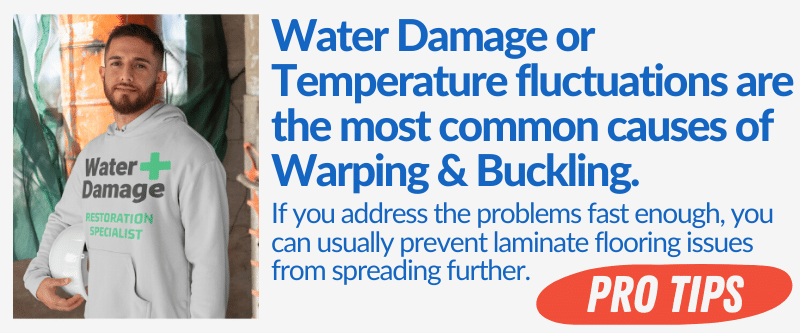
Buckling Laminate Flooring
Unfortunately, with buckling laminate flooring there isn’t a whole lot you can do.
Buckling occurs when your laminate flooring has absorbed moisture, and moisture is detrimental to laminate floors.
That being said, if you’re only experiencing some very mild buckling on a few planks, you can attempt to dry out the boards while coaxing them back to the correct shape.
- As you’re following the drying process, lay some flat, heavy weights down on top of them, such as a large box full of heavy books.
- Things like sandbags will not put enough pressure down evenly, but rather will conform to the buckled planks, so it has to be a flat object with enough weight to even them out.
- Once this is done, continue to follow the drying process, and with any luck the boards will go back to their former state as they dry out.
If you attempt this method and the boards still aren’t flat like they should be, this means its time to replace the buckled planks.
Sanding will ruin them, and things like hot air from hair dryers will only make them worse.
Swollen Patches in Laminate Flooring
Swollen Patches in your laminate flooring will occur after the laminate has soaked up water through the gaps, this will become the most apparent at the edges of individual laminate boards.
As the laminate absorbs the water through the gaps, it will swell up and deform the MDF structure of the laminate.
Even if you completely dry the affected area, deformation in the MDF Fibre structure will remain that of the swollen one. When this happens, there is no way to fix this kind of water damage other than to replace the affected laminate boards.
Bubbles In Laminate Flooring
When moisture absorption followed by drying occurs, the top layer of the laminate might blister up as the moisture evaporates from the material, in what is known as “bubbling.”
When bubbling occurs, you can attempt to fix it with a relatively easy procedure that requires only a sharp precision cutting knife.
It isn’t guaranteed, but in some instances it can repair the cosmetic damage and prevent you from having to replace the plank entirely.
- First, use your finger and feel the blister, or bubble if you will.
- If you’re able to move it around easily with your finger, chances are air is what’s causing the issue.
- Take a sharp precision cutting knife, and cut a tiny hole in the top of the blister, then gently push the air out with your finger.
- You’ll want to make as small a hold as you can, so that it isn’t as visible.
- As you push the air out, the bubble should go down and lay flush with the floor again.
Swollen / Lifting up Laminate Flooring
Most commonly, swelling and lifting occurs with laminate flooring due to temperature change and higher moisture content in air.
If you are Seeing ‘bubbles’ or raised up large swollen patches, see the sections Bubbles and Swollen Patches In Laminate Flooring.
When improperly installed without room for the flooring to expand, it will expand naturally and rise up, creating an uneven surface.
When this happens, the repair is relatively easy, but will require the use of some specialized equipment.
- If you’ve confirmed your floor and room is completely dried out with a moisture meter and are still experiencing buckling, the first thing you’ll want to check is to see if an adequate gap has been left between the edge of the flooring and the wall.
- This will require looking underneath the molding, so you’ll need a prybar to start out with.
- Once the molding has been lifted, there should be a small gap between ¼ and ½ inch from the edge of the last plank to the wall. If there isn’t, you may need to make these gaps yourself.
- A circular saw or a table saw will work best, if you have access to them.
- Once the gaps have been cut, a 100-pound roller acquired from a local hardware store should give you the firm but even pressure to restore your flooring’s even surface.
- Once you’ve done so, check for the gap before reinstalling the molding along the wall.
Laminate Flooring Needs Rescuing?
Call 844-488-0570 for a Risk Free estimate from a Licensed Water Damaged Floor Restoration Specialist in your area.
We Can Help Dry out & Repair your Laminate Flooring!
How To Disinfect Moisture Affected Laminate Floors
If you’re concerned about mold growth, or are simply looking for a good way to keep your floors clean, there are a good number of cleaning products commercially available that are designed specifically for laminate flooring.
Just follow the manufacturer’s instructions carefully, and be sure to get all the moisture up when you’re finished.
If you’re looking for something more along the lines of a DIY cleaner, one popular method is to use equal parts vinegar and hot water in a spray bottle.
- Vinegar isn’t entirely effective as a disinfectant, but it will kill some germs such as E. Coli and Salmonella.
- Mix the components together in a spray bottle, then mist the floor with the solution before wiping it down with a soft microfiber.
- If the smell of vinegar bothers you, feel free to add a few drops of an essential oil of your choosing, or even a bit of your favorite dish detergent.
The total cost will be far less than one of the aforementioned commercial brands, but may not produce the same shine you’re looking for.
In homes with members or guests who are sensitive to the chemicals in cleaning products, however, it makes a fantastic alternative.
How much Does it Cost to Replace Water Damaged Laminate Flooring?
Depending on the size of the area and the type of laminate used, replacing your laminate flooring in its entirety can cost anywhere from $500 to $5,000.
This will also depend on if you are replacing the flooring yourself or hiring someone to do it for you.
If there has been severe water damage and the water has soaked the subfloor as well, this will be an additional expense to properly dry out the subfloor.
The brand of the laminate used also plays a large factor, as some brands are more expensive than others but may also offer warranties.
A brief look around the web will give you all the information you need to do some comparison shopping, but some names to look in to include:
• Pergo with WetProtect
• AquaFlor
• AquaGuard
• Dream Home
• Armstrong Audacity
• Mowhawk RevWood Plus
Many of these offer a warranty when installed in a residential setting, and range anywhere from $1.79 to $3.35 per square foot.
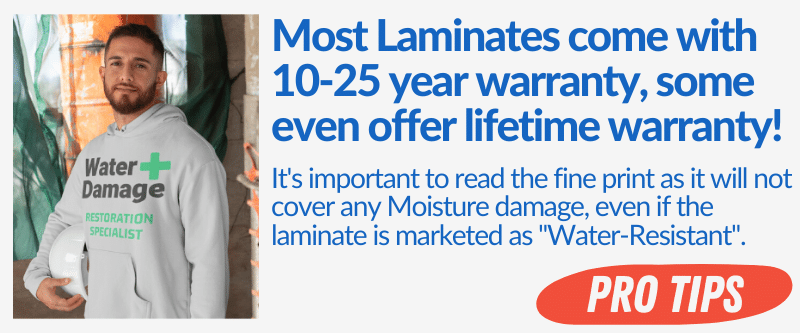
How To Prevent Laminate Floor Water Damage
Of course, the best offense is a good defense, and ideally you’ll never have to worry about water damage to your laminate flooring.
While there’s no sure-fire way to say with 100% certainty you’ll never have the misfortune of experiencing water damage, there are precautions you can take to help minimize the risk.
Can I seal Laminate Flooring to Make it Waterproof?
Most Brands of Laminate are NOT Designed to be sealed as they already have an extremely durable protective layer.
When sealant is applied, laminate flooring can become slippery and dangerous, not to mention any warranty on it might be voided in doing so.
There is however an option to use a crack sealer to seal the gaps of your laminate flooring which would be highly beneficial.
You’ll still need to get the water up off the floor as soon as possible to prevent it from seeping between the planks.
Also, considering the time invested in caulking along every seam and scraping off the excess to keep it even, at that rate you might be better off installing true waterproof flooring.
Not to mention, it won’t exactly make removing or replacing the planks any easier.
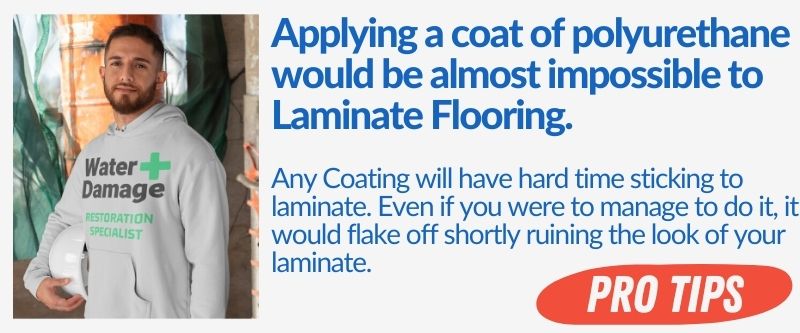
Protecting Laminate Flooring in the Bathroom
When it comes to laminate flooring, bathrooms can become a dangerous area very quickly in terms of moisture and water damage.
Between the sinks, bathtubs, showers, toilets, and the like, there are plenty of opportunities for water to escape, not to mention all the plumbing running through the walls and subflooring.
Vigilance is going to be a key factor when it comes to the bathroom; minimize bathtub splashing, make sure the shower curtain is being properly used to prevent water from dripping onto the laminate floor, and if water ever does make it to the floor, be sure to get it up quickly.
Inspect your water fixtures regularly, and ensure they’re in proper working order.
Look along the caulking of the bathtub, and check the plumbing under your sink for any leaks. If everything looks good and you’re getting the water up off the floor but it still starts to swell up, consider having your plumbing inspected right away.
If taken care of and properly maintained, laminate flooring can survive in most bathrooms.
Protecting Laminate Flooring in the Kitchen
When it comes to laminate flooring in kitchens, installation is key. Though not the ideal flooring for a kitchen, there are ways to safeguard your kitchen’s laminate floor.
The major concerns in a kitchen in terms of water getting on the floor are every-day use.
It isn’t often that a dishwasher is going to flood the floor, but when it does hopefully it doesn’t wind up sitting for several hours or more.
The most common culprit is going to be water from the sink, or sloshing over the side of a pot. Small things that occur simply by living in and using your kitchen.
Just be sure to wipe up water as soon as its spilled, and don’t let it seep in.
As with bathrooms, remain vigilant for any damaged plumbing, or signs of water damage when no source of spilling water is visible.
Kitchens tend to be warmer as well, which can cause issues with laminate flooring, so maintaining a cool temperature when possible would be ideal.
As long as proper maintenance is kept up and barring catastrophic incident, your kitchen laminate should last you a good many years.
When To Call A Professional
The general rule of when to call for help is, any time there’s a significant amount of mold, or any time you feel in over your head.
Important things to consider are whether or not you’re prepared to invest in the tools to perform certain repairs, and whether or not you’re comfortable making those repairs once you do.
Mold poses a tremendous health risk, especially for family members with breathing conditions, so if there is ever even the slightest concern with mold, don’t hesitate to bring in a professional.
If you felt emboldened and began to make a repair yourself, but are starting to feel as though you’re doing more harm than good, stop what you’re doing sooner rather than later and call an expert.
Professionals have access to specialized equipment and training that allows them to find problems you may not have noticed, and are outfitted to ensure your floors are not only properly taken care of, but safe for you and your family as well.
Trust your instincts, and if you feel as though its time to call in an expert, it most likely is.
We have Water Damage Restoration Technicians that can help Dry out your Subfloor and Restore your Laminate Flooring
For Disasters of all Sizes,available in 95% of the USA
